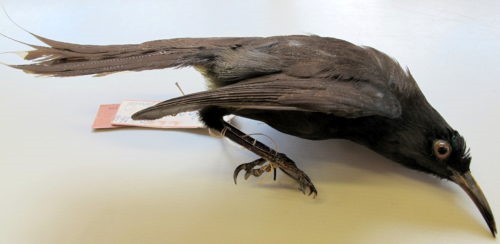Birds of Hawaii: Modern Extinctions
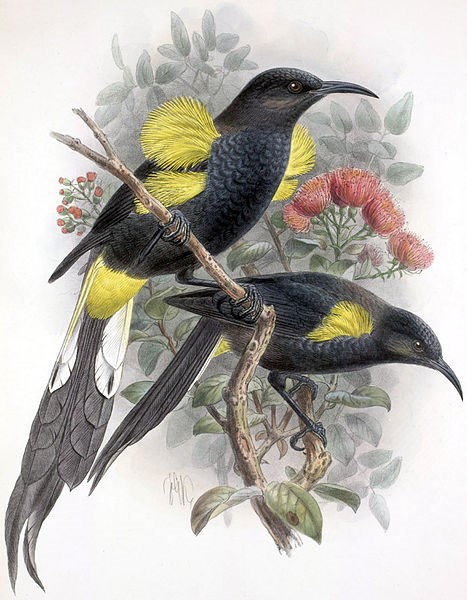
Hawaii O’o, male and female. John Gerrard Keulemans, 1900
Hawaii’s avifauna is a shadow of a shadow of its former self. As the world’s most remote archipelago and a sizeable landmass with diverse habitats, Hawaii was a natural laboratory of avian evolution, but two waves of human colonization extinguished many of Hawaii’s former endemic bird species.
First the Polynesians, whose arrival is estimated at around 1150, hunted many flightless species and a few flighted ones to extinction. These losses are not fully catalogued, but have been revealed in part through the discovery and painstaking analysis of subfossil remains.
Second the Europeans, starting with Captain James Cook in 1778, inadvertently introduced mosquito-borne diseases and predatory rats that have eliminated about half of the endemic species they encountered and continue to threaten several more. European expeditions brought naturalists and collected specimens, including some species that have not been documented again.
Extinct Birds of Hawaii
Laysan Rail / Hawaiian Rail / Kama’o / Amaui / Oloma’o / “Laysan Millerbird” / Kauai O’o / Oahu O’o / Bishop’s O’o / Hawaii O’o / Kioea / Po’o-uli / Kakawahie / Oahu Alauahio / Kona Grosbeak / Lesser Koa-Finch / Greater Koa-Finch / Ula-ai-hawane / Laysan Honeycreeper / Black Mamo / Hawaii Mamo / O’u / Lanai Hookbill / Kauai Nukupu’u / Oahu Nukupu’u / Maui Nukupu’u / Kauai Akialoa / Oahu Akialoa / Maui Nui Akialoa / Lesser Akialoa / Greater Amakihi / Oahu Akepa / Maui Akepa
At least 32 species of Hawaiian birds that survived long enough to be catalogued after European arrival have since gone extinct, along with two others whose status as separate species or subspecies is unsettled. These extinctions include all five known members of an endemic family, the Hawaiian honeyeaters (Mohoidae), and 22 members of a larger endemic group that was formerly classified as a family, now as a tribe, the Hawaiian honeycreepers (Drepanidinini). The other modern extinctions are three thrushes, two or three flightless rails, and one reed-warbler.
Rallidae: Rails, Gallinules, and Coots
Two or three species of flightless rails persisted in Hawaii into the modern era. Others had previously disappeared, likely due to Polynesian colonization of the islands.

Laysan Rail, pair with chicks. John Gerrard Keulemans, 1900
Formerly endemic to Laysan Island.
A small, flightless rail, very closely related to Baillon’s Crake, with essentially the same plumage pattern, but washed out.
Remained common on Laysan Island into the 1910s: population estimates of 2,000 in 1912 and 5,000 in 1915 are considered reasonable. But European Hares introduced in 1903 eventually denuded the one-square-mile island of most of its vegetation. By 1923, a dedicated effort found only two doomed rails remaining on Laysan. At that time, however, introduced populations were well-established on Midway Atoll’s Sand and Eastern Islands. These survived until the accidental introduction of rats to Midway in 1943. The rail was last seen on Eastern Island in July 1944. Although vegetation had by then returned to Laysan Island, there had unfortunately been no attempt in the meantime to re-establish the rail in its original range.

Hawaiian Rail: “Rusty” and “Dusky” forms. John Gerrard Keulemans, 1900
Formerly endemic to the Big Island of Hawaii.
A small, flightless rail, thought to be related to the Ruddy-breasted Crake of eastern Asia. There are two known plumages, which may represent either two species, two subspecies, or two age-classes, adult and immature.
“Rusty Hawaiian Rail” (Z. s. sandwichensis), regarded by many authorities as the immature plumage of Hawaiian Rail, was bright rufous throughout, with darker streaks on the upperparts. Its legs were yellowish and its bill was pale-brown.
“Dusky Hawaiian Rail” (Z. s. millsi), regarded by many authorities as the adult plumage of Hawaiian Rail, was mostly uniform dark-brown with grayish tones on the belly and upperparts. Its legs were orange-yellow and its bill was mostly dark.

“Rusty Hawaiian Rail”, Z. s. sandwichensis. (Presented to Captain James Cook in January or February 1779; Kealakekua Bay, Big Island, Hawaii.) © Naturalis Biodiversity Center
Known from seven specimens: two warm-toned, rusty individuals that Captain James Cook purchased at Kealakekua, Kona, in January 1779, and five collected by a hired native bird-catcher between 1859 and 1864 on the eastern side of the island along the road between Hilo and Kilauea. The last sighting that is considered reliable occurred in 1884 along the same road. (For a discussion of possible relationships between the Kona and Hilo birds see: Frontiers of Taxonomy: Did Two Flightless Rail Species Coexist on Hawaii’s Big Island in Historical Times?)
Based on the specimens collected, it appears that different forms or species inhabited the dry and wet sides of the island: a rufescent form (“Rusty Hawaiian Rail”) on the drier, western side and a dark-brown form (“Dusky Hawaiian Rail”) on the wetter, eastern side.

“Dusky Hawaiian Rail”, Z. s. millsi. © Andrew Esposito
Three of Hawaii’s five native thrushes have gone extinct, probably all due to avian malaria or other insect-borne diseases. Oahu’s thrush disappeared in the mid-1800s, while closely related species on Kauai and Molokai survived until the 1980s.
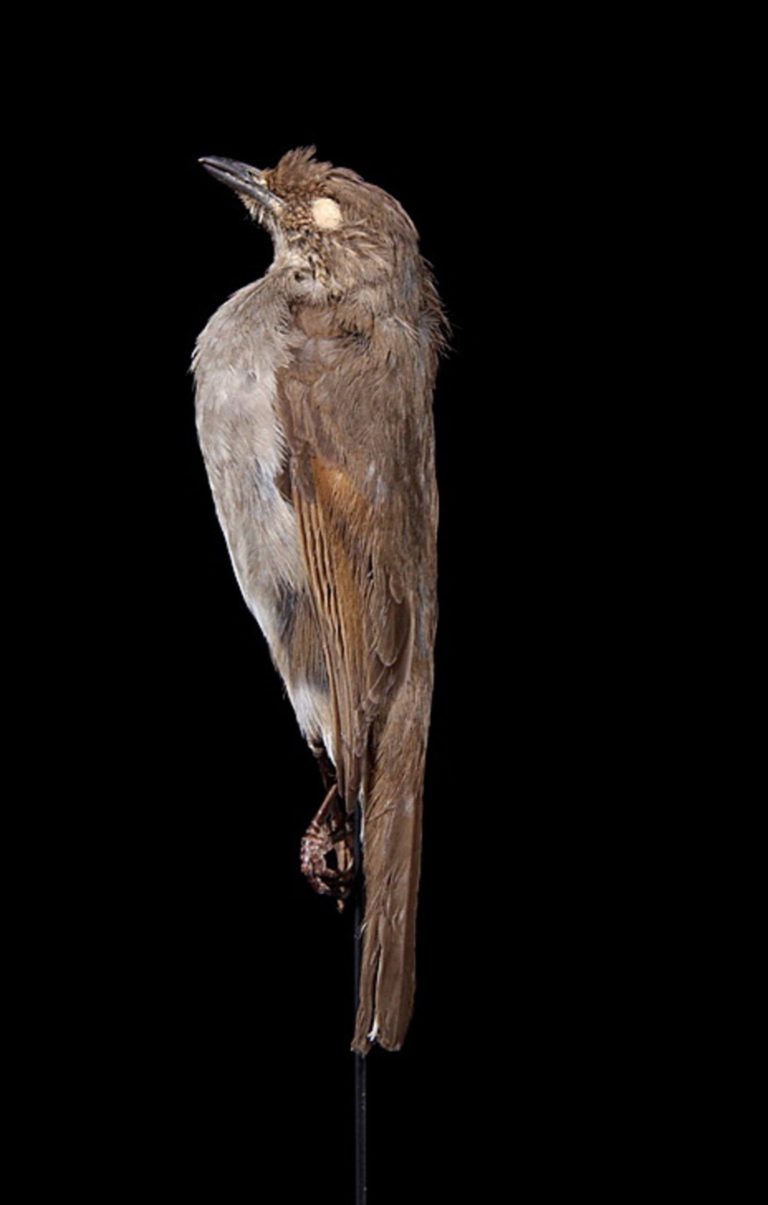
Kama’o. © Naturalis Biodiversity Center
Formerly endemic to Kauai.
A large solitaire with brown upperparts, rusty flight feathers, and grayish underparts faintly scalloped with pale brown. Short, broad bill and dark legs distinguished it from Kauai’s other thrush, the Puaiohi. Traditionally considered conspecific with the Amaui, Oloma’o, and Oma’o, known collectively as the Hawaiian Thrush (Myadestes obscurus), but recognized as separate species since 1982.
The last substantiated observation was the tape-recording of a singing male in the Alakai Swamp on June 27, 1987. Reports without corroborating evidence persisted till at least 1989 and possibly into the 1990s, and it seems clear that the precipitous decline of this species ended with its extinction sometime between June 1987 and the early 1990s. This history is among the most tragic of Hawaii’s endemics. In the late 1800s, the Kama’o was considered to be the most numerous native landbird on Kauai. By 1928 it was found only in montane forests above 1,100 m, then in the early 1970s its population was estimated at 340, and by 1981 it was estimated at 24. This sprint to oblivion seems most likely to have resulted from susceptibility to a pathogen—and it is notable that throughout this process Kauai supported a closely related thrush, the Puaiohi, which was initially uncommon, then rare, but outlived the Kama’o.
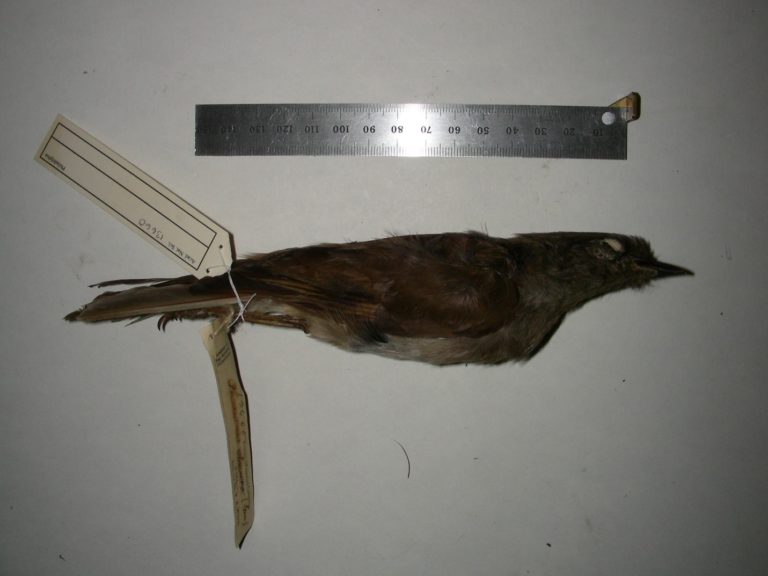
Amaui. (Collected Nu’uanu Valley, Oahu; May 14, 1825.) © Nate Rice / The Academy of Natural Sciences of Drexel University
Formerly endemic to Oahu.
A large solitaire with brown upperparts and grayish underparts. Traditionally considered conspecific with the Kama’o, Oloma’o, and Oma’o, known collectively as the Hawaiian Thrush (Myadestes obscurus), but recognized as separate species since 1982.
The last substantiated observation was the collection of two specimens in Nu’uanu Valley on May 14, 1825. At that time, during the voyage of the HMS Blonde, it was reportedly common on Oahu, but it was not observed during the next major biological research expedition, which was in 1837, and there have been no reports thereafter.
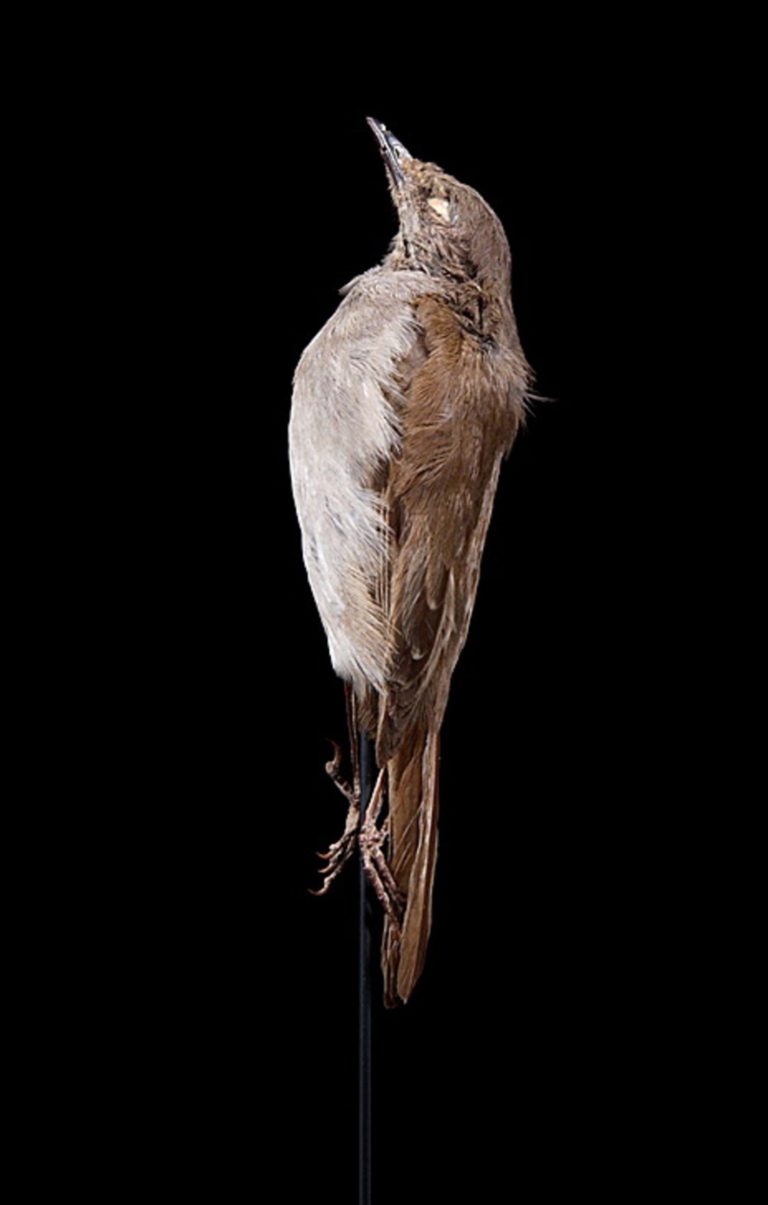
Oloma’o. (Collected on Lanai.) © Naturalis Biodiversity Center
Formerly endemic to Molokai and Lanai; almost certainly extinct.
A large solitaire with brown upperparts and grayish underparts. Traditionally considered conspecific with the Kama’o, Amaui, and Oma’o, known collectively as the Hawaiian Thrush (Myadestes obscurus), but recognized as separate species since 1982.
Remained numerous on both Molokai and Lanai until the 1920s or so, then suddenly declined, likely due to avian malaria. It is believed to have been extirpated from Lanai around 1930, and survived on Molokai until at least 1980, possibly for several years longer. The last documented observations of Oloma’o occurred in 1980, when three were observed on the Olokui Plateau in eastern Molokai. During the previous summer two had been seen at Pu’u Waha’ulu. It seems clear that a small population persisted until at least 1980, and likely beyond. The Olokui Plateau is remote and apparently has not been surveyed since 1980, so it is conceivable that the Oloma’o still survives there. Reports from the Kamakou Preserve in 1988, 1994, and 2005 have not been widely accepted as valid.
Hawaii lost one of its two reed-warblers, the “Laysan Millerbird,” which is usually classified as a subspecies of Millerbird (sibling to the still-surviving “Nihoa Millerbird”). Geographical constraints suggest that these populations were never unified, and the unanswered question is whether they would still be regarded as conspecific with their most recent common ancestor.
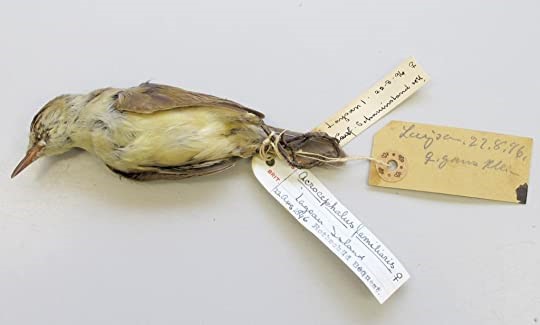
“Laysan Millerbird,” A. f. familiaris, showing extensive yellowish wash on the underparts. © Andrew Esposito
Formerly endemic to Laysan Island.
A typically patterned Acrocephalus reed-warbler with short wings, longish bill and tail, and a yellowish wash on the sides and/or lower belly. The “Laysan Millerbird” (A. f. familiaris) was possibly a separate species from the “Nihoa Millerbird” (A. f. kingi), which has since been introduced to Laysan Island. (See Fleischer, R.C., B. Slikas, C. Atkins, C.E. McIntosh, and S. Conant. 2007. Genetic variability and taxonomic status of the Nihoa and Laysan Millerbirds. Condor 109:954-962.)
Extirpated between 1915 and 1923, when introduced European Hares consumed most of Laysan’s vegetation. In 2011 and ’12, a total of 50 Millerbirds were translocated from Nihoa and by 2014 the Laysan population of “Nihoa Millerbird” was estimated at 164.
Mohoidae: Hawaiian Honeyeaters †
The Hawaiian honeyeaters were a small group of long-billed, long-tailed songbirds that formerly inhabited the main Hawaiian Islands. All five species known to science went extinct in the 1800s and 1900s, making them the only bird family to have gone extinct in modern times. What is believed to have been the final representative of the Hawaiian honeyeater lineage, a male Kauai O’o on a territory deep in the Alakai Swamp, was last heard on April 29, 1987.
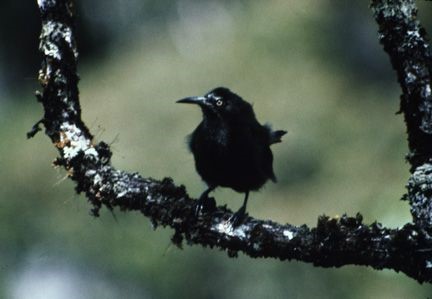
Kauai O’o. (Alaka’i Wilderness Preserve, Kauai, Hawaii; July 1975.) © Robert Shallenberger
The Hawaiian honeyeaters closely resembled the Australasian honeyeaters, and its members were named for that resemblance and originally classified within that family, the Meliphagidae. To the contrary, however, genetic analyses published in 2008 revealed that the Hawaiian honeyeaters were in fact more closely related to several small, largely frugivorous families that comprise a peculiar avian guild: the waxwings, silky-flycatchers, Palmchat, Hylocitrea, and Hypocolius. This surprising revelation led to the posthumous recognition of the Hawaiian honeyeaters as a separate family.

Kauai O’o, immature and adult. John Gerrard Keulemans, 1900
Formerly endemic to Kauai.
A small, nearly all-black honeyeater with yellow thighs and white scalloping on the throat.
Last heard on April 29, 1987, and last seen in 1985. By then, the territory of the last male had been known for several years, and its former mate had not been seen since 1981—presumably killed in November 1982 by Hurricane Iwa, if not sooner. Their nest cavity was in the Alakai Swamp along Halepa’akai Stream. During most of the 1800s, it was regarded as common in all types of forests at all elevations throughout Kauai. By the early 1900s, however, it was mostly limited to the Alakai Plateau.
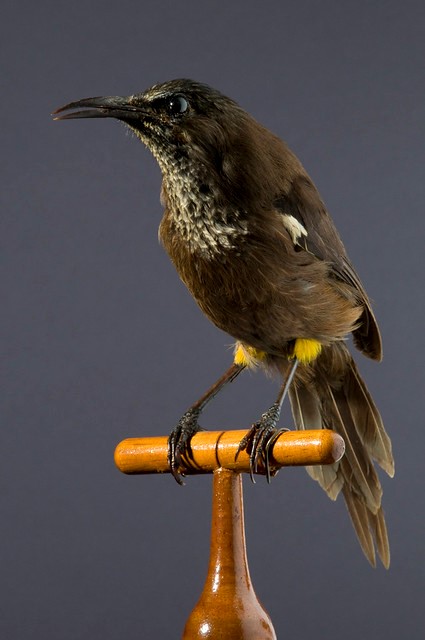
Kauai O’o. (Mounted specimen in Bernice Pauahi Bishop Museum.) © camerai2i

Oahu O’o, male and female. John Gerrard Keulemans, 1900
Formerly endemic to Oahu.
A large, cuckoo-like honeyeater that was black overall with yellow sides, flanks, and vent, white wing linings, and white tips on the tail feathers that were visible on the underside—or as white outer edges on the uppertail. The sexes were similar except that females were somewhat duller and shorter-tailed.
Known only from ten specimens, the last three of which were collected in Nu’uanu Valley between January 11 and 15, 1837. Like other Hawaiian honeyeaters, it was rare in part due to persecution for its feathers. By the time of its formal scientific description in 1860 it was likely extinct.

Bishop’s O’o, male and female. John Gerrard Keulemans, 1900
Formerly endemic to Molokai and likely Maui.
A nearly all-black honeyeater with a yellow vent and yellow tufts on the cheeks and sides. The call was a very loud “five-syllable owów-owów-ów, the last being the loudest and almost a shriek.” (Hume 2017)
A mysterious species. All specimens of it were collected on Molokai, where it was last seen by an ornithologist in 1904, but local residents reported that it persisted until at least 1915. Its historical status on Maui is not clear. There is subfossil evidence of a Moho that inhabited Maui, and field observations at various times were consistent with Bishop’s, so it seems likely to have occurred there.
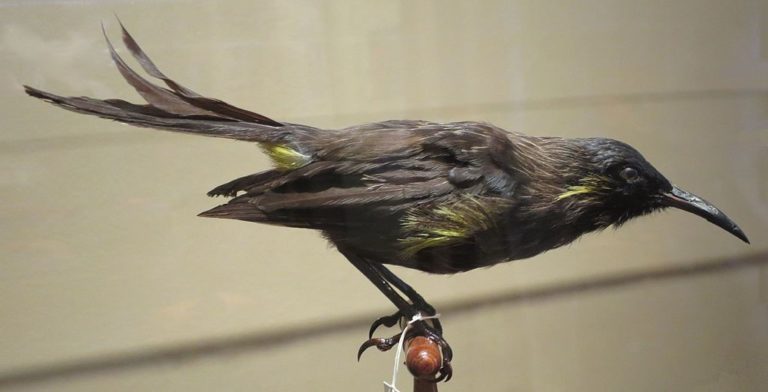
Bishop’s O’o. © Bernice Pauahi Bishop Museum
From the historical period when observers were familiar with Moho from other islands, the last report from Maui was on June 9, 1901, northeast of Olinda at around 900 m elevation. Then in 1973, an observer in eastern Maui reported hearing distinctive vocalizations of an o’o. Finally, in May of 1980 and 1981, in the Ko’olau Forest Reserve, observers reported seeing and positively identifying Bishop’s O’o.

Hawaii O’o, male and female. John Gerrard Keulemans, 1900
Formerly endemic to the Big Island.
A large, cuckoo-like honeyeater that was black overall with a yellow vent and long yellow tufts on the sides. The two outermost tail feathers were short and white, visible mainly from below. The male had elongated central tail feathers with thin curved tips.
Inhabited forests from sea level up to tree-line, but mostly between 700 and 1,200 m. Regarded as common throughout the 1800s, then declined precipitously around the turn of the century. Several other native Hawaiian species declined similarly at the same time, which leaves disease (likely avian malaria) as the only plausible explanation for their mass disappearance. The last documented occurrence was the collection of a specimen near Ka’au Crater on May 13, 1902.
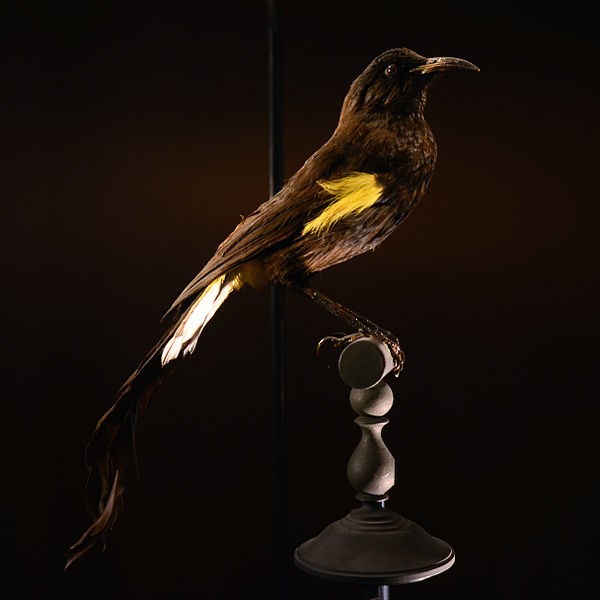
Hawaii O’o, male. (Mounted specimen in Museum National d’Histoire Naturelle, Paris, France.) © Vassil
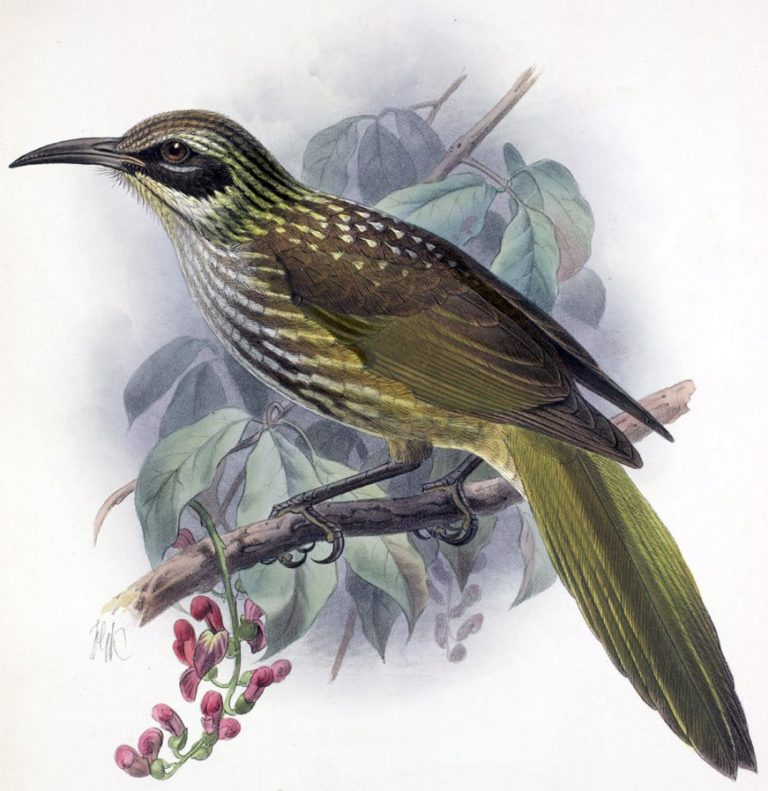
Kioea. (Mounted specimen at Bernice Pauahi Bishop Museum.) © Andrew Esposito
Formerly endemic to the Big Island.
A large, robust honeyeater with a thick decurved bill and a prominent blackish mask. It was olive-brown overall, with dense, bold whitish streaks predominating over the head, neck, underparts, and upper back, and suffused with a yellowish wash on the throat, nape, sides, belly, and tail.
In pattern and coloration it was remarkably similar to the Palmchat (Dulus dominicus) of Hispaniola—a peculiar single-species family that is believed to be among the few fairly close relatives of the Hawaiian honeyeaters. The two species are not known to be similar in any other significant respect, and their proximity in the phylogenetic tree was unknown prior to the 2000s.
Known mainly from four specimens collected between 1840 and 1859 from interior highlands of the Big Island. The precise locations are not well-documented, but are believed to include the Ola’a Tract and dry forests between Mauna Kea and Mauna Loa.
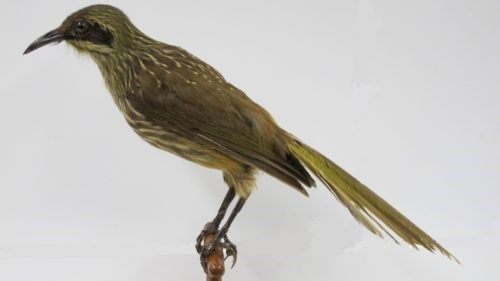
Kioea. (Mounted specimen at Bernice Pauahi Bishop Museum.) © Andrew Esposito

Kioea. (Mounted specimen at Bernice Pauahi Bishop Museum.) © camerai2i
